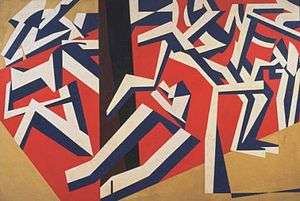Wyndham Lewis
| Wyndham Lewis | |
|---|---|
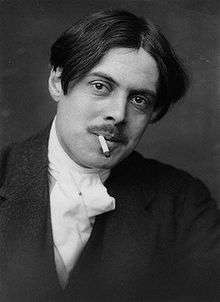 Wyndham Lewis photo by George Charles Beresford, 1913 | |
| Born |
Percy Wyndham Lewis 18 November 1882 Amherst, Nova Scotia, Canada |
| Died |
7 March 1957 (aged 74) London, England |
| Nationality | British |
| Education | Slade School of Art |
| Known for | Painting, Poetry, Literature, Criticism |
| Movement | Vorticism |
| Spouse(s) | Gladys Anne Hoskins (1900–79) |
Percy Wyndham Lewis (18 November 1882 – 7 March 1957) was an English painter and critic (he dropped the name 'Percy', which he disliked). He was a co-founder of the Vorticist movement in art, and edited the literary magazine of the Vorticists, BLAST.[1] His novels include his pre-World War I-era novel Tarr (set in Paris), and The Human Age, a trilogy comprising The Childermass (1928), Monstre Gai and Malign Fiesta (both 1955), set in the afterworld. A fourth volume of The Human Age, The Trial of Man, was begun by Lewis but left in a fragmentary state at the time of his death. He also wrote two autobiographical volumes, Blasting and Bombardiering (1937) and Rude Assignment: A Narrative of my Career Up-to-Date (1950).
Early life
Lewis was reputedly born on his father's yacht off the Canadian province of Nova Scotia.[2] His British mother and American father separated about 1893.[2] His mother subsequently returned to England, where Lewis was educated, first at Rugby School, and then at the Slade School of Art, University College, London, before spending most of the 1900s travelling around Europe and studying art in Paris.
The Omega Workshop and Vorticism

Mainly residing in London from 1908, Lewis published his first work (accounts of his travels in Brittany) in Ford Madox Ford's The English Review in 1909. He was a founder-member of the Camden Town Group in 1911. In 1912 he exhibited his Cubo-Futurist illustrations to Timon of Athens (later issued as a portfolio, the proposed edition of Shakespeare's play never materialising) and three major oil paintings at the second Post-Impressionist exhibition. This brought him into close contact with the Bloomsbury Group, particularly Roger Fry and Clive Bell, with whom he soon fell out. In 1912 he was commissioned to produce a decorative mural, a drop curtain, and more designs[2] for The Cave of the Golden Calf, an avant-garde cabaret and nightclub on London's Heddon Street.[3]
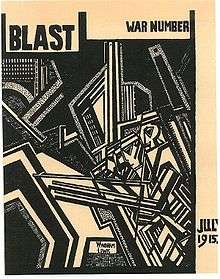
It was in the years 1913–15 that he developed the style of geometric abstraction for which he is best known today, a style which his friend Ezra Pound dubbed "Vorticism." Lewis found the strong structure of Cubist painting appealing, but said it did not seem "alive" compared to Futurist art, which, conversely, lacked structure. Vorticism combined the two movements in a strikingly dramatic critique of modernity. In his early visual works, particularly versions of village life in Brittany showing dancers (ca. 1910–12), Lewis may have been influenced by the process philosophy of Henri Bergson, whose lectures he attended in Paris. Though he was later savagely critical of Bergson, he admitted in a letter to Theodore Weiss (19 April 1949) that he "began by embracing his evolutionary system." Nietzsche was an equally important influence.
After a brief tenure at the Omega Workshops, Lewis quarrelled with the founder, Roger Fry, over a commission to provide wall decorations for the Daily Mail Ideal Home Exhibition, which Lewis believed Fry had misappropriated. He walked out with several Omega artists to start a competing workshop called the Rebel Art Centre. The Centre operated for only four months, but it gave birth to the Vorticist group and the publication, BLAST.[4] In BLAST Lewis wrote the group's manifesto, several essays expounding his Vorticist aesthetic (distinguishing it from other avant-garde practices), and a modernist drama, "Enemy of the Stars." The magazine also included reproductions of now lost Vorticist works by Lewis and others.
World War I: Artillery officer and war artist
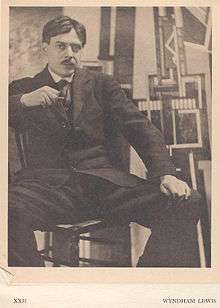
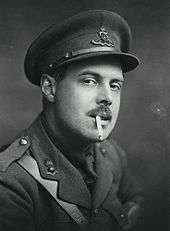
After the Vorticists' only U.K. exhibition in 1915, the movement broke up, largely as a result of World War I, though Lewis's patron, John Quinn, organised a Vorticist exhibition at the Penguin Club in New York in 1917. Lewis was posted to the western front, and served as a second lieutenant in the Royal Artillery. Much of his time was spent in Forward Observation Posts looking down at apparently deserted German lines, registering targets and calling down fire from batteries massed around the rim of the Ypres Salient. It was dangerous work and he made vivid accounts of narrow misses and deadly artillery duels.[5] After the Third Battle of Ypres in 1917, he was appointed as an official war artist for both the Canadian and British governments, beginning work in December 1917.
For the Canadians he painted A Canadian Gun-Pit (1918, National Gallery of Canada, Ottawa) from sketches made on Vimy Ridge. For the British he painted one of his best known works, A Battery Shelled (1919, Imperial War Museum), drawing on his own experience in charge of a 6-inch howitzer at Ypres.[6] Lewis exhibited his war drawings and some other paintings of the war in an exhibition, "Guns," in 1918.
His first novel Tarr was also published in book-form in 1918, having been serialised in The Egoist during 1916–17. It is widely regarded as one of the key modernist texts. Lewis later documented his experiences and opinions of this period of his life in the autobiographical Blasting and Bombardiering (1937), which covered his life up to 1926.
The 1920s

After the war, Lewis resumed his career as a painter, with a major exhibition, Tyros and Portraits, at the Leicester Galleries in 1921. "Tyros" were satirical caricatural figures intended by Lewis to comment on the culture of the "new epoch" that succeeded the First World War. A Reading of Ovid and Mr Wyndham Lewis as a Tyro are the only surviving oil paintings from this series. As part of the same project, Lewis also launched his second magazine, The Tyro, of which there were only two issues. The second (1922) contained an important statement of Lewis's visual aesthetic: "Essay on the Objective of Plastic Art in our Time".[7] It was during the early 1920s that he perfected his incisive draughtsmanship.
By the late 1920s, he was not painting so much, but instead concentrating on writing. He launched yet another magazine, The Enemy (three issues, 1927–29), largely written by himself and declaring its belligerent critical stance in its title. The magazine, and the theoretical and critical works he published between 1926 and 1929, mark his deliberate separation from the avant-garde and his previous associates. Their work, he believed, failed to show sufficient critical awareness of those ideologies that worked against truly revolutionary change in the West. As a result, their work became a vehicle for these pernicious ideologies. His major theoretical and cultural statement from this period is The Art of Being Ruled (1926). Time and Western Man (1927) is a cultural and philosophical discussion that includes penetrating critiques of James Joyce, Gertrude Stein and Ezra Pound that are still read. In the domain of philosophy, Lewis attacked the "time philosophy" (i.e. process philosophy) of Bergson, Samuel Alexander, Alfred North Whitehead and others.
The 1930s
Politics and fiction
In The Apes of God (1930) he wrote a biting satirical attack on the London literary scene, including a long chapter caricaturing the Sitwell family, which did not help his position in the literary world.
In 1931, after a visit to Berlin, Lewis published his book Hitler (1931), which presented Adolf Hitler as a "man of peace" whose party-members were threatened by communist street violence. This confirmed his unpopularity among liberals and anti-fascists, especially after Hitler came to power in 1933. Following a visit to Germany with his wife in 1937, Lewis changed his views and began to retract his previous political comments. He later wrote The Hitler Cult (1939), a book which firmly revoked his earlier willingness to entertain Hitler, but politically Lewis remained an isolated figure in the 1930s. In Letter to Lord Byron, Auden called him "that lonely old volcano of the Right." Lewis thought there was what he called a "left-wing orthodoxy" in Britain in the 1930s. He believed it was not in Britain's interest to ally itself with the Soviet Union, "which the newspapers most of us read tell us has slaughtered out-of-hand, only a few years ago, millions of its better fed citizens, as well as its whole imperial family".[8]
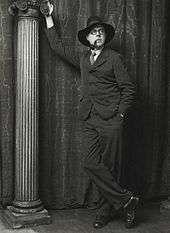
Lewis's novels have been criticised for their satirical and hostile portrayals of Jews, homosexuals, and other minorities. The 1918 novel Tarr was revised and republished in 1928. In an expanded incident a new Jewish character is given a key role in making sure a duel is fought. This has been interpreted as an allegorical representation of a supposed Zionist conspiracy against the West.[9] The Apes of God (1930) has been interpreted similarly, because many of the characters satirised are Jewish, including the modernist author and editor Julius Ratner, a portrait which blends anti-semitic stereotype with historical literary figures (John Rodker and James Joyce; though the Joyce element consists solely in the use of the word "epiphany" in the parody of Rodker included in the novel). A key feature of these interpretations is that Lewis is held to have kept his conspiracy theories hidden and marginalised. Since the publication of Anthony Julius's T. S. Eliot, Anti-Semitism, and Literary Form (1995, revised 2003), where Lewis's anti-semitism is described as "essentially trivial", this view is no longer taken seriously. Somewhat belatedly, he recognised the reality of Nazi treatment of Jews after a visit to Berlin in 1937. He then wrote an attack on anti-semitism: The Jews, Are They Human? (published early in 1939; the title is modelled on a contemporary best-seller, The English, Are They Human?). The book was favourably reviewed in The Jewish Chronicle.
During the years 1934–35 Lewis wrote The Revenge for Love (1937) set in the period leading up to the Spanish Civil War, regarded by many as his best novel. It is strongly critical of communist activity in Spain, and presents English intellectual fellow-travellers as deluded.
Lewis' interests and activities in the 1930s were by no means exclusively political. Despite serious illness necessitating several operations, he was very productive as a critic and painter, and produced a book of poems, One-Way Song, in 1933 (the link below gives access to a recording of him reading an extract). He also produced a revised version of Enemy of the Stars, first published in Blast in 1914 as an example to his literary colleagues of how Vorticist literature should be written. It is a proto-absurdist, Expressionist drama, and some critics have identified it as a precursor to the plays of Samuel Beckett. An important book of critical essays also belongs to this period: Men without Art (1934). It grew out of a defence of Lewis's own satirical practice in The Apes of God, and puts forward a theory of 'non-moral', or metaphysical, satire. But the book is probably best remembered for one of the first commentaries on Faulkner, and a famous essay on Hemingway.
Return to painting
After becoming better known for his writing than his painting in the 1920s and early 1930s, he returned to more concentrated work on visual art, and paintings from the 1930s and 1940s constitute some of his best-known work. The Surrender of Barcelona (1936–37) makes a significant statement about the Spanish Civil War. It was included in an exhibition at the Leicester Galleries in 1937 that Lewis hoped would re-establish his reputation as a painter. After the publication in The Times of a letter of support for the exhibition, asking that something from the show be purchased for the national collection (signed by, among others, Stephen Spender, W. H. Auden, Geoffrey Grigson, Rebecca West, Naomi Mitchison, Henry Moore and Eric Gill) the Tate Gallery bought the painting, Red Scene. Like others from the exhibition, it shows an influence from Surrealism and de Chirico's Metaphysical Painting. Lewis was highly critical of the ideology of Surrealism, but admired the visual qualities of some Surrealist art.
Lewis then also produced many of the portraits for which he is well-known, including pictures of Edith Sitwell (1923–36), T. S. Eliot (1938 and again in 1949) and Ezra Pound (1939). The rejection of the 1938 portrait of Eliot by the selection committee of the Royal Academy for their annual exhibition caused a furore, with front-page headlines prompted by the resignation of Augustus John in protest. However, no less an authority than Walter Sickert once claimed that: 'Wyndham Lewis [is] the greatest portraitist of this or any other time', though it was left to Lewis to make this statement public.
Marriage
In 1930, Wyndham Lewis married Gladys Anne Hoskins (1900–79), affectionately known as ‘Froanna’. The couple never had children; Lewis’s past experience, combined with the irregularity of his income and devotion to his work probably provided a practical basis for the couple’s childlessness. Lewis had shown little affection for his two children born by Iris Barry, with whom he lived from 1918 to 1921.[10][11]
In the 1930s Lewis kept Froanna in the background, and many of his friends were simply unaware of her existence. It seems that Lewis was extraordinarily jealous and protective of his wife, owing to her youth and beauty (she was eighteen years his junior). They lived together for ten years before marrying. Froanna was patient and caring toward her husband through financial troubles and his frequent illnesses. She was the model for some of Lewis’s most tender and intimate portraits, as well as a number of characters in his fiction. In contrast to his earlier, rather impersonal portraits, which are purely concerned with external appearance, the portraits of Froanna show a preoccupation with her inner life.[12]
The 1940s and after
Lewis spent World War II in the United States and Canada. Artistically the period is mainly important for the series of watercolour fantasies around the themes of creation, crucifixion and bathing that he produced in Toronto in 1941–42. He returned to England in 1945. By 1951, he was completely blind. In 1950 he published the autobiographical Rude Assignment, in 1951 a collection of allegorical short stories about his life (and the life of his friends) in "the capital of a dying empire," entitled "Rotting Hill",[13][14] and in 1952 a book of essays on writers such as George Orwell, Jean-Paul Sartre and André Malraux, entitled "The Writer and the Absolute". This was followed by the semi-autobiographical novel "Self Condemned" (1954), a major late statement.
The Human Age and retrospective exhibition
The BBC now commissioned him to complete the 1928 The Childermass, which was broadcast in 1955, in a dramatisation by D. G. Bridson, on the Third Programme and published as The Human Age.[15] The 1928 volume was set in the afterworld, "outside Heaven" and dramatised in fantastic form the cultural critique Lewis had developed in his polemical works of the period. The continuations take the protagonist, James Pullman (a writer), to a modern Purgatory and then to Hell, where Dantesque punishment is inflicted on sinners by means of modern industrial techniques. Pullman becomes chief advisor to Satan (here known as Sammael) in his scheme to undermine the divine and institute a "Human Age". The work has been read as continuing the self-assessment begun by Lewis in Self Condemned. But Pullman is not merely autobiographical; the character is a composite intellectual, intended to have wider representative significance.
In 1956 the Tate Gallery held a major exhibition of his work, "Wyndham Lewis and Vorticism," in the catalogue to which he declared that "Vorticism, in fact, was what I, personally, did and said at a certain period"—a statement which brought forth a series of "Vortex Pamphlets" from his fellow "BLAST" signatory William Roberts.
A pituitary tumour which had made him blind since 1951 (its growth placing pressure on the optic nerve) ended his artistic career, though he continued writing until his death in 1957.
Always interested in Roman Catholicism, he nevertheless never converted.
Lewis wrote 40 books. Other works include Mrs. Duke's Million (written about 1908-9 but not published until 1977); Snooty Baronet (a satire on behaviorism, 1932); Doom of Youth (a sociological account of youth culture, 1932); The Red Priest (his last novel, 1956); and The Demon of Progress in the Arts (on extremism in the visual arts, 1954).

In recent years there has been a renewal of critical and biographical interest in Lewis and his work, and he is now regarded as a major British artist and writer of the twentieth century. An exhibition of his books, magazines, paintings and drawings was held at Rugby School in November 2007 to commemorate the 50th anniversary of his death. The National Portrait Gallery in London held a major retrospective of his portraits in 2008. In 2010 Oxford World Classics published a critical edition of the 1928 text of "Tarr" edited by Scott W. Klein of Wake Forest University. The Nasher Museum of Art at Duke University held an exhibition entitled "The Vorticists: Rebel Artists in London and New York, 1914–18" from 30 September 2010 through 2 January 2011.[16] The exhibition then travelled to the Peggy Guggenheim Collection, Venice (29 January – 15 May 2011: 'I Vorticisti: Artisti ribellia a Londra e New York, 1914–1918') and then to Tate Britain under the title 'The Vorticists: Manifesto for a Modern World' between 14 June and 4 September 2011.
Several readings by Lewis are collected on The Enemy Speaks, an audiobook CD published in 2007 and featuring extracts from "One Way Song" and "The Apes of God", as well as radio talks titled "When John Bull Laughs" (1938), "A Crisis of Thought" (1947) and "The Essential Purposes of Art" (1951).[17]
A blue plaque now stands on the house in Kensington where Lewis lived, No. 61 Palace Gardens Terrace.[18]
Books
- Tarr (1918) (novel)
- The Caliph's Design : Architects! Where is Your Vortex? (1919) (essay)
- The Art of Being Ruled (1926) (essays)
- The Wild Body: A Soldier Of Humour And Other Stories (1927) (short stories)
- The Lion and the Fox: The Role of the Hero in the Plays of Shakespeare (1927) (essays)
- Time and Western Man (1927) (essays)
- The Childermass (1928) (novel)
- Paleface: The Philosophy of the Melting Pot (1929) (essays)
- Satire and Fiction (1930) (criticism)
- The Apes of God (1930) (novel)
- Hitler (1931) (essay)
- The Diabolical Principle and the Dithyrambic Spectator (1931) (essays)
- Doom of Youth (1932) (essays)
- Filibusters in Barbary (1932) (travel; later republished as Journey into Barbary)
- Enemy of the Stars (1932) (play)
- Snooty Baronet (1932) (novel)
- One-Way Song (1933) (poetry)
- Men Without Art (1934) (criticism)
- Left Wings over Europe; or, How to Make a War about Nothing (1936) (essays)
- Blasting and Bombardiering (1937) (autobiography)
- The Revenge for Love (1937) (novel)
- Count Your Dead: They are Alive!: Or, A New War in the Making (1937) (essays)
- The Mysterious Mr. Bull (1938)
- The Jews, Are They Human? (1939) (essay)
- The Hitler Cult and How it Will End (1939) (essay)
- America, I Presume (1940) (travel)
- The Vulgar Streak (1941) (novel)
- Anglosaxony: A League that Works (1941) (essay)
- America and Cosmic Man (1949) (essay)
- Rude Assignment (1950) (autobiography)
- Rotting Hill (1951) (short stories)
- The Writer and the Absolute (1952) (essay)
- Self Condemned (1954) (novel)
- The Demon of Progress in the Arts (1955) (essay)
- Monstre Gai (1955) (novel)
- Malign Fiesta (1955) (novel)
- The Red Priest (1956) (novel)
- The Letters of Wyndham Lewis (1963) (letters)
- The Roaring Queen (1973; written 1936 but unpublished) (novel)
- Unlucky for Pringle (1973) (short stories)
- Mrs Duke's Million (1977; written 1908-10 but unpublished) (novel)
- Creatures of Habit and Creatures of Change (1989) (essays)
References
- ↑ Grace Glueck (22 September 1985). "Wydham Lewis:Painter, Polemicist, Iconoclast". New York Times. Retrieved 11 June 2015.
- 1 2 3 Richard Cork, ‘Lewis, (Percy) Wyndham (1882–1957)’, Oxford Dictionary of National Biography, Oxford University Press, 2004 (http://www.oxforddnb.com/index/101034517/)
- ↑ Program and menu from The Cave of the Golden Calf, Cabaret and Theatre Club, Heddon Street
- ↑ "The Art and Ideas of Wyndham Lewis", FluxEuropa.
- ↑ Paul Gough (2010) ‘A Terrible Beauty’: British Artists in the First World War (Sansom and Company) 203–239.
- ↑ Stephen Farthing (Editor) (2006). 1001 Paintings You Must See Before You Die. Cassell Illustrated/Quintessence. ISBN 978-1-84403-563-2.
- ↑ Tyro, scans of the publication at The Modernist Journals Project website.
- ↑ Time and Tide, 2 March 1935, p. 306.)
- ↑ Ayers, David. (1992) Wyndham Lewis and Western Man. Basingstoke and London: Macmillan.
- ↑ National Portrait Gallery. "Portrait of Froanna". National Portrait Gallery. Retrieved 10 June 2015.
- ↑ National Portrait Gallery. "Froanna -Portrait of the Artist's Wife". National Portrait Gallery. Retrieved 10 June 2015.
- ↑ David Trotter (23 January 2001). "A most modern misanthrope: Wydham Lewis and the pursuit of anti-pathos". The Guardian / London Review of Books. Retrieved 10 June 2015.
- ↑ Wyndham Lewis "Rotting Hill"
- ↑ Notting Hill history: 5 – Rotting Hill, 1940s (PDF), Kensington & Chelsea Community History Group, retrieved 10 February 2012
- ↑ The Human Age. Wyndham Lewis. The Listener (London, England), Thursday, June 2, 1955; pg. 976; Issue 1370
- ↑ Nasher Museum Retrieved 17 September 2010
- ↑ Wyndham Lewis "The Enemy Speaks"
- ↑ "Wyndham Lewis blue plaque". openplaques.org. Retrieved 11 May 2013.
Further reading
- Ayers, David. (1992) Wyndham Lewis and Western Man. Basingstoke and London: Macmillan.
- Chaney, Edward (1990) "Wyndham Lewis: The Modernist as Pioneering Anti-Modernist", Modern Painters (Autumn, 1990), III, no. 3, pp. 106–09.
- Edwards, Paul. (2000) Wyndham Lewis, Painter and Writer. New Haven and London: Yale U P.
- Edwards, Paul and Humphreys, Richard. (2010) "Wyndham Lewis (1882–1957)". Madrid: Fundación Juan March
- Gasiorek, Andrzej. (2004) Wyndham Lewis and Modernism. Tavistock: Northcote House.
- Gasiorek, Andrzej, Reeve-Tucker, Alice, and Waddell, Nathan. (2011) Wyndham Lewis and the Cultures of Modernity. Aldershot: Ashgate.
- Grigson, Geoffrey (1951) 'A Master of Our Time', London: Methuen.
- Jaillant, Lise. "Rewriting Tarr Ten Years Later: Wyndham Lewis, the Phoenix Library and the Domestication of Modernism." Journal of Wyndham Lewis Studies 5 (2014): 1-30.
- Jameson, Fredric. (1979) Fables of Aggression: Wyndham Lewis, the Modernist as Fascist. Berkeley, Los Angeles and London: University of California Press.
- Kenner, Hugh. (1954) Wyndham Lewis. New York: New Directions.
- Klein, Scott W. (1994) The Fictions of James Joyce and Wyndham Lewis: Monsters of Nature and Design. Cambridge: Cambridge University Press.
- Leavis, F.R. (1964). "Mr. Eliot, Mr. Wyndham Lewis and Lawrence." In The Common Pursuit, New York University Press.
- Michel, Walter. (1971) Wyndham Lewis: Paintings and Drawings. Berkeley: University of California Press.
- Meyers, Jeffrey. (1980) The Enemy: A Biography of Wyndham Lewis. London and Henley: Routledge & Keegan Paul.
- Morrow, Bradford and Bernard Lafourcade. (1978) A Bibliography of the Writings of Wyndham Lewis. Santa Barbara: Black Sparrow Press.
- Normand, Tom. (1993) Wyndham Lewis the Artist: Holding the Mirror up to Politics. Cambridge. Cambridge University Press.
- O'Keeffe, Paul. (2000) Some Sort of Genius: A Biography of Wyndham Lewis. London: Cape.
- Orage, A. R. (1922). "Mr. Pound and Mr. Lewis in Public." In Readers and Writers (1917-1921), London: George Allen & Unwin, Ltd.
- Rothenstein, John (1956). "Wyndham Lewis." In Modern English Painters. Lewis To Moore, London: Eyre & Spottiswoode.
- Rutter, Frank (1922). "Wyndham Lewis." In Some Contemporary Artists, London: Leonard Parsons.
- Rutter, Frank (1926). Evolution in Modern Art: A Study of Modern Painting, 1870-1925, London: George G. Harrap.
- Schenker, Daniel. (1992) Wyndham Lewis: Religion and Modernism. Tuscaloosa: U of Alabama Press.
- Spender, Stephen (1978). The Thirties and After: Poetry, Politics, People (1933-1975), Macmillan.
- Waddell, Nathan. (2012) Modernist Nowheres: Politics and Utopia in Early Modernist Writing, 1900-1920. Basingstoke: Palgrave Macmillan.
- Wagner, Geoffrey (1957). Wyndham Lewis: A Portrait of the Artist as the Enemy, New Haven: Yale University Press.
- Woodcock, George, ed. Wyndham Lewis in Canada. Vancouver: University of British Columbia Publications, 1972.
External links
| Wikimedia Commons has media related to Wyndham Lewis. |
| Wikiquote has quotations related to: Wyndham Lewis |
- "“Long Live the Vortex!” and “Our Vortex” (1914) by Lewis at the Poetry Foundation
- Website of the Wyndham Lewis Society
- Portraits at the National Portrait Gallery, London.
- "Time and Western Man" essay from Yale
- "Self Condemned," essay about Lewis and Canada in The Walrus, October 2010
- "The Enemy Speaks" audiobook CD by Lewis
Archives
- Wyndham Lewis Collection at the Division of Rare and Manuscript Collections, Cornell University Library
- Wyndham Lewis' Art Collection at the Harry Ransom Center at The University of Texas at Austin
- Wyndham Lewis collection at University of Victoria, Special Collections
- Art and Literary Works by Wyndham Lewis from the C. J. Fox Collection at University of Victoria, Special Collections
- Wyndham Lewis Collection (archival) and (book collection) at Clara Thomas Archives & Special Collections at York University
